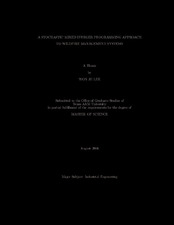| dc.contributor.advisor | Ntaimo, Lewis | |
| dc.creator | Lee, Won Ju | |
| dc.date.accessioned | 2010-01-15T00:13:51Z | |
| dc.date.accessioned | 2010-01-16T02:12:31Z | |
| dc.date.available | 2010-01-15T00:13:51Z | |
| dc.date.available | 2010-01-16T02:12:31Z | |
| dc.date.created | 2006-08 | |
| dc.date.issued | 2009-06-02 | |
| dc.identifier.uri | https://hdl.handle.net/1969.1/ETD-TAMU-1801 | |
| dc.description.abstract | Wildfires have become more destructive and are seriously threatening societies and our
ecosystems throughout the world. Once a wildfire escapes from its initial suppression
attack, it can easily develop into a destructive huge fire that can result in significant
loss of lives and resources. Some human-caused wildfires may be prevented; however,
most nature-caused wildfires cannot. Consequently, wildfire suppression and contain-
ment becomes fundamentally important; but suppressing and containing wildfires is
costly.
Since the budget and resources for wildfire management are constrained in reality, it is imperative to make important decisions such that the total cost and damage
associated with the wildfire is minimized while wildfire containment effectiveness is
maximized. To achieve this objective, wildfire attack-bases should be optimally located such that any wildfire is suppressed within the effective attack range from
some bases. In addition, the optimal fire-fighting resources should be deployed to the
wildfire location such that it is efficiently suppressed from an economic perspective.
The two main uncertain/stochastic factors in wildfire management problems are
fire occurrence frequency and fire growth characteristics. In this thesis two models
for wildfire management planning are proposed. The first model is a strategic model
for the optimal location of wildfire-attack bases under uncertainty in fire occurrence.
The second model is a tactical model for the optimal deployment of fire-fighting resources under uncertainty in fire growth. A stochastic mixed-integer programming
approach is proposed in order to take into account the uncertainty in the problem
data and to allow for robust wildfire management decisions under uncertainty. For
computational results, the tactical decision model is numerically experimented by two
different approaches to provide the more efficient method for solving the model. | en |
| dc.format.medium | electronic | en |
| dc.format.mimetype | application/pdf | |
| dc.language.iso | en_US | |
| dc.subject | Stochastic Programming | en |
| dc.subject | Wildfire Management | en |
| dc.title | A stochastic mixed integer programming approach to wildfire management systems | en |
| dc.type | Book | en |
| dc.type | Thesis | en |
| thesis.degree.department | Industrial and Systems Engineering | en |
| thesis.degree.discipline | Industrial Engineering | en |
| thesis.degree.grantor | Texas A&M University | en |
| thesis.degree.name | Master of Science | en |
| thesis.degree.level | Masters | en |
| dc.contributor.committeeMember | Butenko, Sergiy | |
| dc.contributor.committeeMember | Gan, Jianbang | |
| dc.type.genre | Electronic Thesis | en |
| dc.type.material | text | en |
| dc.format.digitalOrigin | born digital | en |


